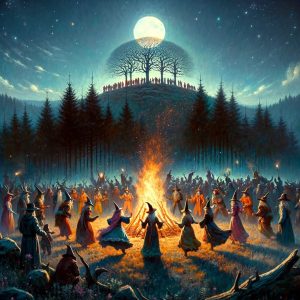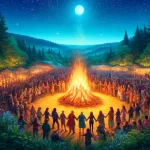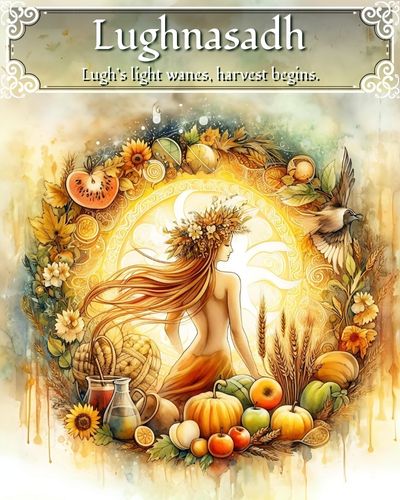
Approx. Reading time: About 18 Minutes

Introduction
Igniting the Fires of Joy and Renewal
Beltane, also known as May Day, is a pagan holiday that celebrates the beginning of summer and the fertility of the earth. It is typically observed on May 1st, though some traditions celebrate the full moon that falls closest to this date. It’s a time of great celebration, and there are many traditions associated with this festival. Beltane has a rich history and is still celebrated today in various ways by many different pagans and neopagan groups.

History of Beltane:
Beltane is a festival that dates to ancient Celtic culture when it was celebrated as the start of summer and the time when the herds were driven out to their summer pastures. This important holiday was also associated with fertility and the coming of new life, and it was celebrated with great joy and merriment. Beltane was a time for feasting, dancing, and ritualized bonfires, as people celebrated the growth and abundance of the natural world.
The name Beltane comes from the Gaelic “Bealtaine,” which means “bright fire” or “lucky fire.” This refers to the bonfires that were traditionally lit on this occasion. In ancient times, Beltane was a time of purification and renewal, when people would light fires to burn away the old and welcome in the new. The festival was also associated with the god Bel, who was associated with the sun and the power of growth and fertility.
The Celts believed that Beltane was a time when the veil between the worlds was thin, and that the spirits of the Otherworld could more easily communicate with the living. As such, Beltane was a time of great magic and ritual, and it was believed that spells cast on this day would be particularly powerful. The festival was also seen as a time of union between the god and goddess, and it was a time for couples to celebrate their love and fertility.
May Day:
Beltane, also known as May Day, is a celebration that marks the arrival of summer. The name “May Day” refers to the specific day on which Beltane is traditionally observed, which is the first day of May. The term “May Day” has its roots in medieval Europe and is often associated with various customs and traditions that honor the changing of seasons and the awakening of nature.
While Beltane and May Day are often used interchangeably to refer to the same festive occasion, there are slight differences in their cultural origins and specific practices. Beltane has ancient Celtic roots and is deeply connected to the Gaelic traditions of Ireland, Scotland, and other Celtic regions. It is a significant festival that celebrates the turning of the seasons and the renewal of life.
On the other hand, May Day is a more widespread term that encompasses a broader range of customs and celebrations observed throughout Europe and beyond. It has its origins in pre-Christian pagan traditions and has been influenced by various cultural and religious practices over time. May Day is often associated with the welcoming of spring and the honoring of fertility and abundance.
While both Beltane and May Day share a common theme of celebrating the arrival of summer, Beltane tends to emphasize the Celtic and pagan traditions, focusing on the sacred union of the masculine and feminine forces, fertility rituals, and the lighting of bonfires. May Day, on the other hand, may encompass a wider range of customs such as maypole dancing, flower crowning, and the giving of May baskets.
In summary, Beltane and May Day are two terms used to describe the same festive occasion, celebrating the onset of summer and the awakening of nature. Beltane has stronger associations with Celtic and pagan traditions, while May Day is a broader term that includes a variety of customs observed across different cultures. Regardless of the terminology, both Beltane and May Day offer an opportunity to rejoice in the beauty of nature, honor the cycles of life, and embrace the vibrant energies of the season.
Present Day:
Today, Beltane is still celebrated by many Pagans and Wiccans around the world. While some aspects of the holiday have changed over time, such as the shift away from driving herds to summer pastures, many of the core themes and practices remain the same. Beltane is still a time for celebrating the earth’s fertility and the coming of new life. It is also seen as a time of transition and transformation, a time to leave behind the old and welcome in the new. Beltane is still seen as a time for celebrating the abundance and fertility of the natural world, and for honoring the power of the sun and the earth.
Some of the traditional practices associated with Beltane include dancing around the Maypole, which is decorated with ribbons and flowers. The Maypole represents the phallus of the god and the fertility of the earth. Many people also light bonfires or candles to celebrate the return of the sun and the coming of summer. Some Pagans also perform rituals to honor the god and goddess, and to ask for their blessings of fertility and abundance.
Traditions:
Embracing the spirit of Beltane means immersing ourselves in a tapestry of ancient traditions that celebrate the arrival of summer and the vibrant energy of life. These time-honored customs have been passed down through generations, weaving together a rich tapestry of joy, fertility, and renewal. From the dancing of the Maypole to the lighting of bonfires, Beltane traditions ignite our spirits and connect us to the rhythms of nature. In this section, we delve into the enchanting traditions of Beltane, exploring bonfires, Maypoles, flower craft, feasts, and courtship.
Bonfires: Illuminating Beltane’s Magic and Protection
One of the most captivating and revered traditions of Beltane is the lighting of bonfires. These blazing beacons hold profound symbolism and play a vital role in the celebration of this ancient festival. As Beltane marks the arrival of summer and the resurgence of light, the bonfires serve as powerful focal points, illuminating the path ahead and infusing the festivities with warmth and enchantment.
The significance of the bonfire tradition in Beltane stretches back through the ages. These fires are not merely sources of light and heat but also bearers of profound meaning. They symbolize the return of the sun’s radiant energy, embodying the transformative power of warmth and light that nourishes the Earth and encourages the growth of crops and life itself.
Beyond their symbolic representation, bonfires hold practical purposes as well. In the olden times, these fires were believed to possess potent purifying and protective qualities. The crackling flames and billowing smoke were thought to hold the magic to dispel negativity and ward off malevolent spirits. The cleansing properties of the bonfires served as a safeguard for the community, ensuring a prosperous and harmonious transition into the summer season.
To partake in the tradition of bonfires during Beltane, find a suitable outdoor space where the flames can dance freely under the open sky. Choose a location that allows for safe and controlled burning, adhering to any local regulations or guidelines. Gather dry and flammable materials such as wood, twigs, or branches, and arrange them in a pyramid or teepee shape to encourage airflow and maintain a steady burn.
As the sun dips below the horizon, ignite the bonfire with a sacred flame, channeling your intentions and invoking the spirit of Beltane. Allow the fire to grow and flourish, casting its warm glow and casting away the shadows of the past. As you gather around the bonfire with loved ones, feel the transformative energy radiating from the flames and embrace the sense of unity and connection it evokes.
Magically, the bonfire holds immense power. As you bask in its light, visualize any negativity or obstacles being consumed by the flames. Allow the transformative energy of the fire to purify your spirit and invite in positive blessings. You may also choose to perform rituals or ceremonies around the bonfire, such as writing intentions or wishes on pieces of paper and casting them into the fire, or dancing joyously around the flames to honor the season’s vitality.
The tradition of bonfires during Beltane is a sacred and awe-inspiring practice, embodying the spirit of transformation, protection, and renewal. Through the dance of flickering flames, we embrace the return of the sun’s energy, symbolize the shedding of the old and the embrace of the new, and invoke the collective power of the community as we embark on the journey of the vibrant summer season.
Maypole and Maypole Dancing: Weaving the Tapestry of Unity and Fertility
One of the most enchanting and visually captivating traditions of Beltane is the Maypole dance. Central to this tradition is the Maypole, a tall and beautifully decorated pole that stands as a symbol of fertility, unity, and the interconnectedness of all beings. As the Maypole is erected in a prominent location, it becomes a focal point for the community to come together and celebrate the vibrant energies of Beltane.
The Maypole dance holds deep significance and embodies the essence of Beltane’s spirit. As people gather around the Maypole, they engage in a joyous dance, weaving colorful ribbons in and out of the pole. The intertwining of these ribbons symbolizes the harmonious union of masculine and feminine energies, the dance of life and creation. It represents the vital interplay between the forces of nature and the divine, reminding us of the eternal dance of balance and harmony.
The Maypole dance holds profound importance, fostering a sense of community and unity. It is a celebration of togetherness, where people join hands and move in synchronized patterns, creating a vibrant tapestry of movement and color. Through this communal dance, individuals become interconnected, symbolizing the interdependence of all life. It is a powerful reminder that we are all part of a larger web, and our actions and energies are woven together in a collective celebration of fertility and life.
To partake in the Maypole dance, find a suitable location where the Maypole can be securely anchored. The pole itself is traditionally adorned with colorful ribbons, flowers, and other festive decorations. As the dance commences, participants each hold onto a ribbon, and as they move in a circular pattern around the Maypole, they alternately pass over and under each other, creating intricate patterns with the ribbons.
The dance can be accompanied by traditional music, singing, and laughter, further enhancing the joyful and festive atmosphere. As the dance progresses, the ribbons become more tightly intertwined around the Maypole, creating a visual representation of unity and connection. The dance culminates in a glorious display of the beautifully woven ribbons, symbolizing the abundance and fertility that Beltane brings forth.
Magically, the Maypole dance is imbued with transformative energy. As participants move and intertwine the ribbons, they infuse their intentions, wishes, and blessings into the dance. The vibrant and joyful energy generated during the dance is believed to enhance fertility, creativity, and the manifestation of desires. It is a moment to celebrate the potency of life force and the power of communal intention.
The tradition of Maypole and Maypole dancing during Beltane is a cherished and celebratory practice that honors the interconnectedness of all beings, the dance of creation, and the vibrant energies of fertility. Through the communal dance, we tap into the harmonious union of masculine and feminine, weaving together a tapestry of unity, joy, and abundance. May the Maypole be a beacon of celebration and a reminder of the interconnectedness that lies at the heart of Beltane’s spirit.
Flower Craft: Embracing Nature’s Beauty and Abundance
Flowers have long held a special place in the traditions of Beltane, serving as vibrant symbols of beauty, fertility, and the flourishing of life. They play a significant role in the celebration of this joyful festival, adorning the Maypole, crowning the heads of participants, and weaving through garlands and wreaths. The presence of flowers during Beltane is a visual reminder of the abundant blessings bestowed upon us by the Earth and a testament to the cycle of life and renewal.
The use of flowers in Beltane rituals and celebrations holds great importance. They represent the essence of fertility, serving as a vibrant expression of the Earth’s ability to bring forth new life. The blooming petals and vibrant colors of flowers embody the beauty and abundance that emerges during the spring and summer seasons. They remind us of the interconnectedness between humans and nature, and the mutual support we share in the cycle of life.
To engage in the tradition of Flower Craft during Beltane, one can explore a myriad of creative and magical activities. Creating flower crowns or garlands is a popular practice, allowing individuals to adorn themselves with the vibrant hues and fragrant scents of blossoms. Gather a variety of fresh flowers, choosing those that resonate with you and hold symbolic meaning. With gentle hands, weave the stems together, intertwining the blooms to form a crown or a garland that reflects your intentions and desires for the Beltane season.
Another way to incorporate Flower Craft into your Beltane celebrations is through the creation of floral arrangements and displays. Select an assortment of seasonal flowers, paying attention to their colors, shapes, and fragrance. Arrange them in vases, baskets, or other containers, placing them as centerpieces on your altar, around your sacred space, or within your home. As you arrange the flowers, infuse them with your intentions, expressing gratitude for the abundance of nature and welcoming the energies of growth and renewal into your space.
Magically, flowers hold a multitude of benefits and can enhance the energetic vibrations of your Beltane celebrations. They possess a gentle and nurturing energy that promotes harmony, love, and connection with the natural world. Incorporating flowers into your rituals and practices during Beltane can help cultivate an atmosphere of joy, beauty, and transformation. Their fragrance and colors can uplift the spirit and inspire a sense of wonder and gratitude.
The tradition of Flower Craft during Beltane is a beautiful way to honor the fertility and abundance of the Earth. Through the creative use of flowers, we celebrate the growth and blossoming of nature, expressing our gratitude for the gifts of the season. Engaging with flowers during Beltane allows us to forge a deeper connection with the natural world and tap into the transformative energies of renewal and vitality. May the blooms of Beltane be a testament to the infinite beauty and potential that lies within the cycles of nature.
Feasts and Gatherings: Nourishing the Body and Spirit at Beltane
Food holds a special place in the traditions of Beltane, as it is a time of celebration and abundance. The feasting and gathering that take place during this festival are integral to the joyful spirit of Beltane. It is a moment to come together with loved ones and community, to share in the bountiful harvest of the season, and to express gratitude for the gifts of the Earth.
Feasting during Beltane is not merely a physical act of nourishment; it holds deep symbolic significance. The foods prepared and shared during this time are infused with the energy of fertility, growth, and new beginnings. Each dish represents the Earth’s abundant offerings, carrying the essence of the season and the blessings of the land.
To partake in the tradition of feasts and gatherings during Beltane, consider organizing a community gathering or a potluck-style feast. Invite friends, family, and like-minded individuals to join in the celebration of the season. Encourage each person to bring a dish that reflects the abundance and flavors of the season. Traditional Beltane foods such as oatcakes, honey cakes, and mead can be incorporated into the feast, as they carry symbolic meanings associated with fertility, sweetness, and new life.
As you prepare and share the feast, infuse your intentions and gratitude into the food. Consider offering a blessing or prayer, expressing gratitude for the Earth’s generosity and the nourishment it provides. Share stories, laughter, and joyous moments as you savor the flavors and the company of those around you. By coming together in this way, you honor the interconnectedness of all beings and create a sense of unity and community.
Magically, the act of feasting during Beltane is infused with transformative energy. As you consume the foods prepared with intention and gratitude, you assimilate the energetic qualities they carry. The feast becomes a sacred ritual, where the energy of fertility, growth, and abundance is transferred to you. It is an opportunity to connect with the energies of the Earth and to align yourself with the cycles of nature, allowing for personal transformation and renewal.
The tradition of feasts and gatherings during Beltane is a cherished practice that nourishes both the body and the spirit. It is a moment to celebrate the blessings of the Earth, to connect with loved ones and community, and to express gratitude for the abundance that surrounds us. By partaking in the feast, we acknowledge our interconnectedness with the natural world and embrace the vitality and joy of the season. May the shared meals of Beltane be a reminder of the sustenance and blessings that flow from the Earth, and may they deepen our connection to the cycles of life and the vibrant energies of the season.
Love and Courtship: Embracing Romance and Union at Beltane
Beltane is often regarded as a time of love, romance, and courtship. It is believed that the vibrant energies of the season and the fertility of the Earth create an atmosphere conducive to deep connections and the blossoming of relationships. The tradition of love and courtship during Beltane celebrates the beauty of human connections and the sacred union of two souls.
The importance of love and courtship during Beltane lies in the recognition of the transformative power of relationships and the joyous celebration of human connection. It is a time to honor and cherish the bonds we share with our beloved partners, to express our affection, and to celebrate the divine union of masculine and feminine energies. Beltane provides a sacred space to reaffirm our commitment to love, to celebrate the union of hearts, and to express gratitude for the transformative and nurturing qualities of deep connections.
To engage in the tradition of love and courtship during Beltane, consider embracing rituals and ceremonies that symbolize your love and commitment. Handfasting, a type of Pagan wedding ritual, is a cherished practice during Beltane. It involves the binding of hands with ribbons or cords, symbolizing the union of two souls in love and commitment. This ritual can be performed publicly or privately, with vows exchanged and promises made to honor and nurture the relationship.
Another way to honor love and courtship during Beltane is to engage in activities that deepen the connection with your partner. Spend quality time together in nature, go on walks, or have a picnic in a beautiful outdoor setting. Take the opportunity to express your feelings through words, gestures, or acts of kindness that strengthen the bond between you. Engaging in acts of love and courtship during Beltane not only strengthens your connection but also invites the energies of love and harmony into your relationship.
Magically, the tradition of love and courtship during Beltane is infused with transformative and nurturing energies. The sacredness of love and commitment is heightened during this time, as the Earth blooms with life and vitality. By engaging in rituals and practices that honor love, you invite the blessings of harmonious partnerships, deep connections, and transformative growth. Beltane provides a powerful energetic backdrop to manifest and amplify the love and joy in your life.
The tradition of love and courtship during Beltane is a beautiful reminder of the profound impact that love and deep connections have on our lives. It is a time to celebrate the power of love, to honor our beloved partners, and to express gratitude for the transformative nature of relationships. May the practices of love and courtship during Beltane bring joy, connection, and a deepening of love within your life. May they strengthen the bonds between souls and foster a sense of unity and harmony in relationships.
Beltane is a vibrant and joyful festival that encompasses a rich tapestry of traditions. From the lighting of bonfires and the weaving of Maypole ribbons to the crafting of flower crowns and the sharing of feasts, each tradition holds its own significance and symbolism. These practices connect us to the cycles of nature, honor the Earth’s abundance, and celebrate the beauty of human connections, love, and courtship. As we engage in these traditions, we tap into the transformative energies of Beltane, fostering a deeper connection to ourselves, our communities, and the natural world. Through the observance of these customs, we embrace the vitality of the season, express gratitude for the gifts of the Earth, and invite joy, love, and harmony into our lives. May the traditions of Beltane continue to inspire and uplift us, reminding us of the interconnectedness of all beings and the power of celebration, unity, and renewal.
Modern Practices:
In modern times, Beltane is often celebrated as a family-friendly festival. Many people host picnics or outdoor gatherings, and children may participate in activities such as making flower crowns or creating May baskets to give to friends and loved ones. Beltane is also a time for handfasting ceremonies, which are pagan wedding rituals that celebrate the union of two people in love.
Family Friendly Activities:
Beltane can be a great holiday to celebrate with children. Family-friendly activities may include making flower crowns or May baskets to give to neighbors, decorating eggs or other spring-themed crafts, or having a picnic or outdoor gathering. It can also be a time to teach children about the earth’s cycles and the importance of honoring and respecting the natural world.
For families with children, Beltane can be a fun and creative time for them to participate in activities such as making flower crowns or creating May baskets to give to friends and loved ones. These activities can help children connect with the natural world and learn about the importance of honoring the changing seasons.
Many Beltane celebrations also involve the creation of floral wreaths or garlands. These can be worn on the head or hung in homes or sacred spaces to honor the coming of spring and the abundance of new growth. In addition, Beltane is a time for feasting and sharing food with loved ones. Many Beltane celebrations involve potluck meals, picnics, or barbecues.
Beltane is also a time for connecting with the natural world and honoring the spirits of nature. Many people take this opportunity to go on a nature walk, plant a garden, or simply spend time outside in meditation or contemplation. Beltane is a reminder of our interconnectedness with all living things and the importance of caring for the earth.
Another modern practice of Beltane is to engage in acts of kindness and community service. Some people may choose to volunteer at local gardens or parks, or to organize a neighborhood clean-up effort. These acts of service can help to bring people together and create a sense of shared purpose and community. Additionally, Beltane can be a time to reflect on personal growth and renewal, and to set intentions for the coming months of the year. This may involve participating in personal rituals or meditations to connect with one’s inner self and the energies of the season.
Many modern pagans have developed their own Beltane rituals and practices. These may include creating altars or shrines to honor the season, performing nature walks or hikes to connect with the earth’s energy, or making offerings to deities associated with fertility and growth.
Adult Activities:
Beltane is a holiday that celebrates fertility and new beginnings, and for adults who want to explore this theme in more intimate ways, there are several activities to choose from. One popular activity is attending Beltane festivals or gatherings, where individuals can connect with like-minded individuals and participate in group rituals or ceremonies. These events often feature live music, dancing, and fire performances, adding to the festive atmosphere.
Another option for adults is to have a private ritual or ceremony with a partner or small group of friends. This may involve creating a sacred space, lighting candles or a fire, and engaging in intimate acts of love and connection. For those who practice sex magic, Beltane is a particularly auspicious time to channel the power of sexual energy to manifest their desires or intentions.
Exploring one’s own sexuality and desires is also a common practice during Beltane. Some may choose to take part in sensual activities, such as sensual massage or sensual dancing, to celebrate the sensual pleasures of life. Additionally, some may use the holiday as an opportunity to explore and express their own sexual identities and desires.
It is important to note that while Beltane is a celebration of fertility and sexuality, it is also a time for respecting boundaries and consent. Any activities involving sexual energy should be approached with mindfulness and respect for all involved. It is also important to recognize that Beltane celebrations can be inclusive of all genders and sexual orientations.
Finally, Beltane can also be a time for personal reflection and spiritual growth. Some people choose to use this time to set intentions for the coming months, to practice divination, or to connect with their spiritual guides and ancestors.
The modern practices of Beltane offer us an opportunity to connect with the ancient traditions in a way that is meaningful and relevant to our lives today. By engaging in outdoor activities, harvest crafts, nature-based rituals, and community sharing, we deepen our connection to the cycles of nature, honor the Earth’s abundance, and celebrate the spirit of Beltane. These practices invite us to cultivate gratitude, creativity, and a sense of unity with the natural world and our communities. As we embrace the modern expressions of Beltane, we tap into the transformative energies of the season, fostering personal growth, joy, and a deepening of our spiritual connection. May these practices inspire us to live in harmony with nature, celebrate the cycles of life, and cultivate a sense of awe and reverence for the beauty that surrounds us.
Conclusion:
Beltane is a powerful and transformative festival that celebrates the vitality of life, the abundance of the Earth, and the interconnectedness of all beings. Rooted in ancient traditions and customs, Beltane offers us an opportunity to reconnect with the cycles of nature, express gratitude for the gifts of the Earth, and celebrate the beauty of love, growth, and unity. Whether we engage in traditional rituals, modern practices, or a combination of both, Beltane invites us to embrace the joy, creativity, and renewal that this sacred time embodies. As we kindle the fires of our spirits and weave the ribbons of connection, let us embrace the transformative energies of Beltane and cultivate a deep sense of gratitude, reverence, and celebration for the wonders of life. May Beltane inspire us to live in harmony with nature, nurture our relationships, and awaken the vibrant energies within us.












